Fertilizers and fungicides become irreplaceable assistants to gardeners in the struggle for a healthy and plentiful crop. Along with modern expensive means, there is an undeservedly forgotten budget drug iron sulfate, which has a detrimental effect for numerous microorganisms, while simultaneously healing plants. Being a contact substance, it does not accumulate in cells, carefully protecting from pests, saturates the soil with iron, bringing invaluable help to plants.
Material Content:
Iron sulfate: gardening applications
Iron plays one of the leading roles in oxidative and energy metabolism in cells, in the formation of chlorophyll, in the respiratory system of plants. The use of iron sulfate in horticulture on saline, carbonate soils, where iron is not absorbed by plants due to a pH of 7 or more, an excess of calcium, phosphorus, magnesium and other antagonists is a necessary condition, since vitriol is the only concentrated source of iron that can give a plant a trace element in an easily accessible form.

In gardening, iron sulfate or 53% iron sulfate (crystalline greenish powder) has a wide range of possibilities. It is used mainly in the form of aqueous solutions for root and foliar top dressing of a certain concentration and in an unchanged form for addition to compost.
Purpose of application and norms:
- Prevention of fungal diseases. It is produced by spraying the soil, trees and bushes (1-3% solution: 100-300 g / 10 l).
- Treatment of fungal diseases: scab, powdery mildew, spotting, rot rot and others by repeated spraying, as the protective period lasts up to 10-14 days (3-5% solution: 300-500 g / 10 l).
- Prevention and treatment of non-infectious chlorosis - yellowing of leaves from iron deficiency: watering the soil with solutions of low concentration and repeated spraying of the leaves with a prepared composition with citric acid (iron chelate) until color is restored (0.01-0.05% solution: 1-5 g / 3 l).
- Destruction of insect pests and their larvae: apple thistle, aphid, codling moth, cabbage scoop, leaf beetle, slugs and others by spraying soil, bark of branches, trunks (500 g / 10 l).
- Getting rid of moss and lichens, the present punishment of the shady, moist corners of the garden and old trees. Garden trees, shrubs are sprayed, paths, stones, lawn watered (400-500 g / 10 l).
- Disinfection of wounds, cracks in the cortex and the treatment of appearing hollows in the trunks (100 g per 1 liter of water).
The interest of homeowners is caused by the property of iron sulfate to disinfect cesspools and common areas several times more effective than bleach, without harming the environment, odorless and cheaper than similar modern biological products.
You can use to remove mold from concrete and wooden bases of basements and cellars, decorating wooden structures.
What plants can be fertilized with iron sulfate?
Iron is necessary for all plants, without exception, for full growth and fruiting. Potato, cabbage, corn, tomatoes, grapes, legumes, fruit, citrus and ornamental plants react especially sensitively to its lack of soil.
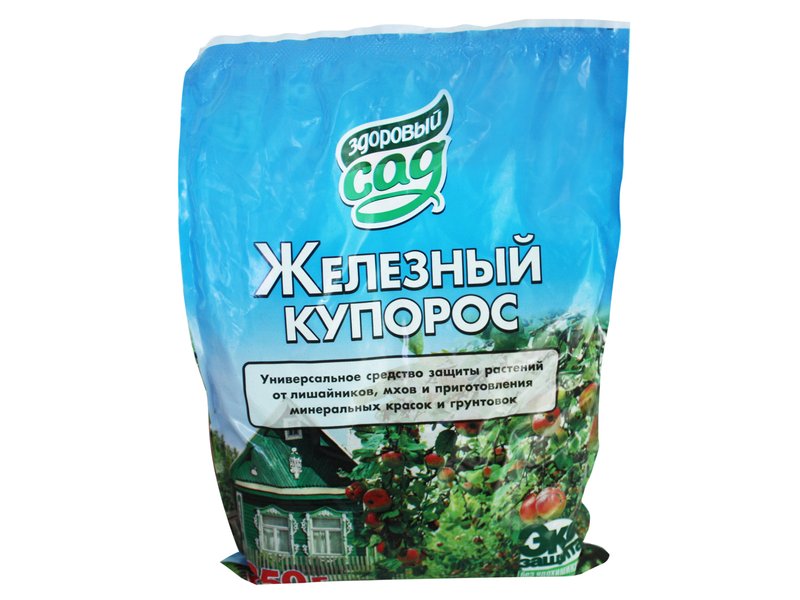
Evidence of iron starvation (chlorosis) are young leaves of shoot tops that brighten to a lemon color. Old ones become yellow-brown in the presence of bright green central and lateral veins, with subsequent drying, as well as deformed, undeveloped shoots and crumbling ovaries. It is possible to correct the situation by spraying the leaves with a 0.05-0.1% aqueous solution of iron sulfate (5-10 g of powder per 10 l of water) with a break of 5-7 days or a chelated form of iron (with the addition of citric acid in the solution), where iron is more Stable and absorbed by plants faster and more efficiently.
Such irrigation can also be carried out for preventive purposes, for example, on tomato bushes, chlorine manifestations are possible with a sufficient amount of iron in the soil, but drought or high humidity at high temperatures, excess lime or ash with excessive feeding do not allow the bushes to absorb it. Potato tubers processed before planting will be protected from scab. Adding 100 g of vitriol to compost (10 kg) or 1 m2 during digging will improve the soil structure and increase the yield.
In no case do not exceed the dosage of the substance - due to the increased acidity of iron sulfate, leaves and stems will receive significant burns until the death of the plant.
Instructions for use
Having a versatile effect, iron sulfate is used in different concentrations as a single drug or combined with citric acid or ascorbic acid (an impromptu iron chelate).
How to breed a drug?
To prepare the solution, glass or plastic containers are used, since upon contact with metal, the effectiveness of the substance decreases.
Only soft water is used: rain or melt. Gently pour the required amount of powder into water and stir with a wooden or plastic spatula until the crystals are completely dissolved.
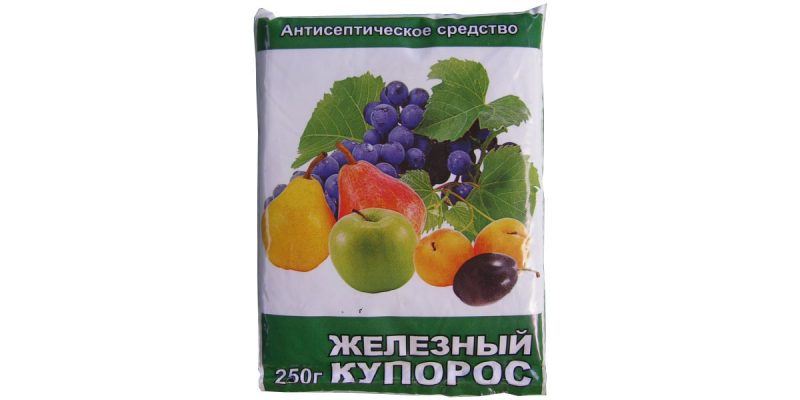
In the absence of weights, the desired amount of vitriol can be measured using a teaspoon containing:
- 5 g of iron sulfate;
- 8 g of citric acid.
A tablespoon - 20 g of iron vitriol, 80 ml of a stack filled to the top contains 100 g of vitriol.
Self-preparation of a solution close to iron chelate.
With citric acid:
- in 1 liter of soft water, dissolve 8 g of citric acid using a non-metallic spatula;
- add 5 g of iron sulfate.
Add another 2 L of water to the resulting solution. Upon complete dissolution of the ingredients, an orange liquid is obtained having a concentration of 0.5% iron (II) sulfate. Use the drug immediately.
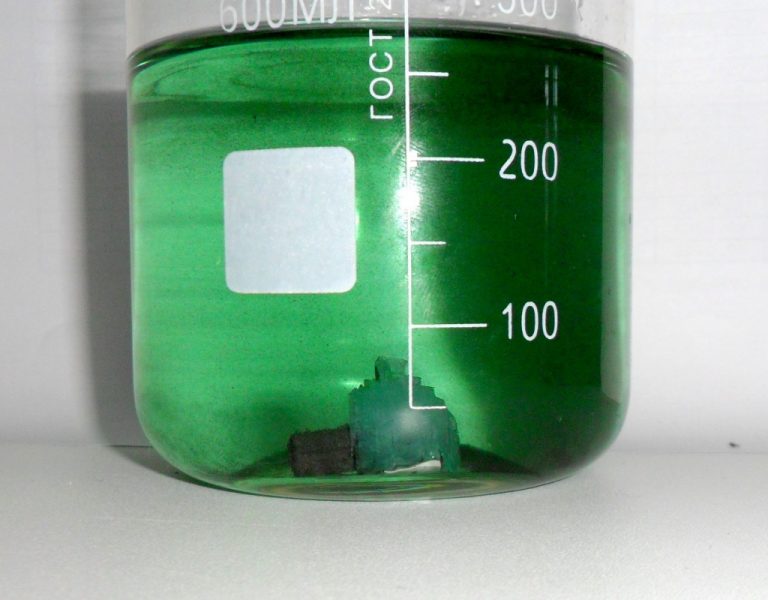
With ascorbic acid.
For 3 liters of water:
- 5 g of iron sulfate;
- 10 g of ascorbic acid.
The preparation of the mixture occurs according to the principle of the first recipe. Important ascorbic acid should be pure, free of glucose and other additives. Given the rapid oxidation of iron, use the composition immediately.
Such a chelate complex during decomposition does not leave harmful compounds, it is used for the treatment and prevention of chlorosis, but when using solutions of pure iron sulfate it is important to remember - Violation of the instructions for the use of iron sulfate entails inevitable consequences: small doses will not have the expected effect, large ones will cause irreparable harm.
How to spray and water?
Processing of the garden with iron sulfate is carried out in calm, dry weather, taking into account the weather forecast for the next few days, as it is unstable and washed off by rain. When the solution dries, a constricting film forms under which the spores of the fungi, larvae and eggs of insect pests die. This film is soluble, therefore it is washed off with dew, rain over time. For greater effect, re-treatment is required after 10-14 days. The sprayed area should cover the crown of trees, branches of bushes, and the soil under them.
Processing cracks, wounds, hollows, mossy areas and painting the trunks are done with a brush.
Do not mix whitewash with lime, karbofos, vitriol and similar substances - the therapeutic effect disappears, compounds dangerous to the plant appear.
Soil acidification, its saturation with iron can be combined with irrigation, the concentration of the solution is 5% (500 g / 10 l).
Nuances of processing in spring, autumn
Proper use of iron sulfate significantly increases the fruiting and taste of the fruit, the healthy flowering of ornamental plants and flowers.
The main condition for the safe treatment of the garden with concentrated iron sulfate is to spray only the sleeping buds, that is, before the sap flow in the spring or until it stops completely in the fall.
Spring application stops the development of growth buds, creating a tightening film for about 2 weeks, which allows the vine (4%), fruit trees: stone fruit (3%), pome fruit (5%), rose bushes (3%) and other sensitive plants to survive the cold period painlessly.

Spraying is carried out in early spring, after harvesting the remaining residues of leaves, branches, grass. Pests and larvae that wintered in cracks in the bark and soil will disappear, saturation of the soil with iron (3%) will save strawberries, raspberries, currants from the worst enemy - spotting and other fungal infections. That's just iron sulfate will not save from bacterial diseases, unlike copper sulfate, which can be used to treat the garden only after 1.5-2 months. Therefore, experienced gardeners treat the garden with iron sulphate in the fall and in the spring sprayed with copper sulfate.
The treatment of trees with iron sulfate in autumn is carried out on bare shoots, before the winter shelter of the bushes, after harvesting the leaves.
Compatibility with other top dressings
Due to the acidity of iron sulfate (pH 3, 5), it is not recommended to mix it with alkaline reaction preparations, with solutions of calcium, boron, zinc, copper, magnesium. Attaching laundry soap to grip the surface, its reaction should be neutral. Neglecting the recommendations, you can at best not get the expected result in the worst case harm the plant.
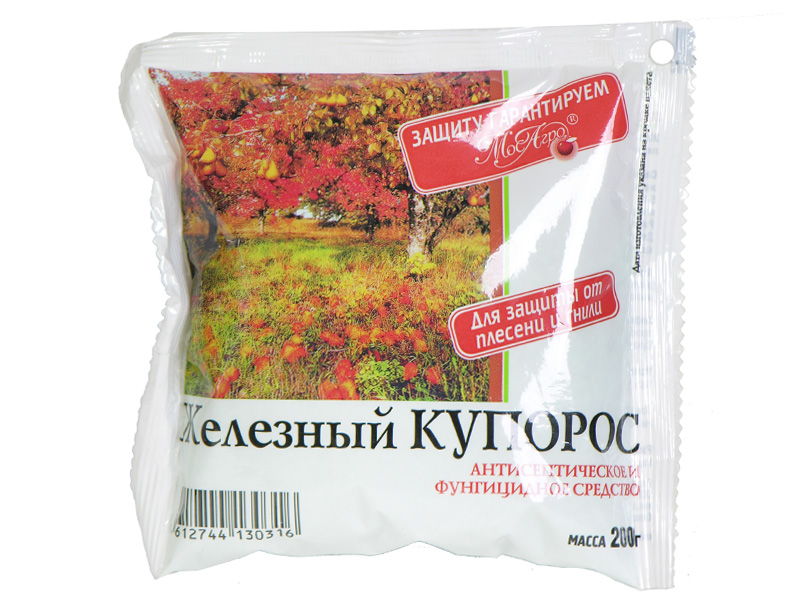
Experienced gardeners recommend using separate preparations (without mixing), withstanding a break of at least 2-3 weeks between use.
Precautions for use
Iron sulfate belongs to hazard class III, respectively, it is necessary to protect the skin and mucous membranes of the eyes and respiratory tract from direct contact, which has an irritating effect: gloves, protective clothing, respirator, headgear.
Before using the substance, free the area from the presence of pets. After using the drug, wash the skin with soap and water.
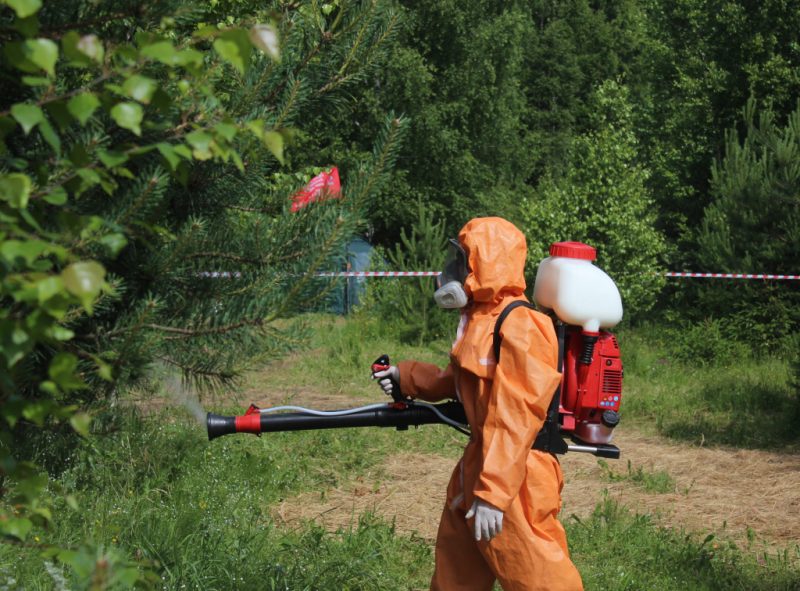
In case of contact with the skin and mucous membranes of the eyes - rinse with plenty of running water, inside - take the sorbent, consult a doctor.
Iron sulfate is a popular drug among gardening masters that performs protective functions, saturates the soil with iron, and saves money on new plants.












